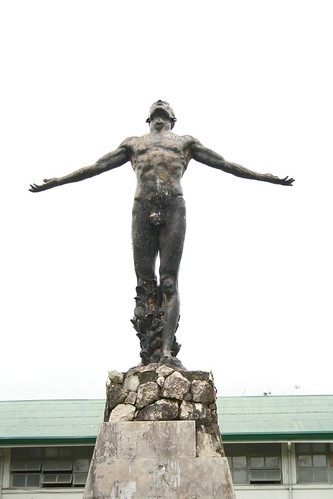
The University of the Philippines, which I am an alumnus, has one little tradition every 16th of December -- the oblation run. At the sound of siren at 12 noon, you'll see some men run around the campus with a red rose... naked. Actually it's an annual tradition of one of the most prominent fraternities of the university, the Alpha Phi Omega (APO).
So where did the idea of men running in their naked glory come from?
The Oblation is a sculpture and the iconic symbol of the University of the Philippines -- a "completely nude figure of a young man with outstretched arms and open hands, with tilted head, closed eyes and parted lips murmuring a prayer, with breast forward in the act of offering himself", as described by its sculptor Guilermo Tolentino. It symbolizes selfless offering of one's self to his country. Others say that it also represents truth -- that truth is naked.
The bronze-colored concrete sculpture is 3.5 meters in height, symbolizing the 350 years of Spanish rule in the Philippines. A leaf called siempreviva (always living) and locally known as kataka-taka (literally means "startling") covers the oblation's genitals. Kataka-taka has a characteristic of starting shoots from its very leaf. The sculptor, said that the leaf symbolizes "the deep-rooted patriotism in the heart of our heroes". The rocky base represents the rugged Philippine archipelago.
There are inscriptions on all four sides of the statue's pedestal. On the front panel is an excerpt from Jose Rizal's "El Filibusterismo," a passage from Padre Florentino, asking where are the youth ready to offer their lives and their aspirations for the country?
At the back of the statue is one stanza from Rizal's "Mi Ultimo Adios," again referring to the giving of one's life, "in combat or in martyrdom." Still another stanza from that poem appears on the right side of the statue, again talking about offering one's life, "without doubts, without sorrow."
On the other hand, APO's oblation run started in 1977 to protest the banning of the movie, “Hubad na Bayani,” which depicted human rights abuses in the martial law era.Today, it became and expression of protest to the current political or economic situation of the country.
I was able to witness the oblation run when I was a freshman and it was my first and last. I just think it's not a pleasing sight and an exhibitionism rationalized. The symbol of the Oblation, though, is something that every UP alumni should be pondering upon.
Sunday, December 14, 2008
Nekkid
Sunday, December 14, 2008
Subscribe to:
Post Comments (Atom)







2 comments:
I'm an alumnus too from CMC---I was 17 (a freshman) and so naive and I had the first shock of my life when these 4 men frolicked around the AS hall naked but with their faces covered in shirts.
I was a student from 1980-1984 there but I've never witnessed it. But I am proud of the Oblation and what it stands for!
Post a Comment